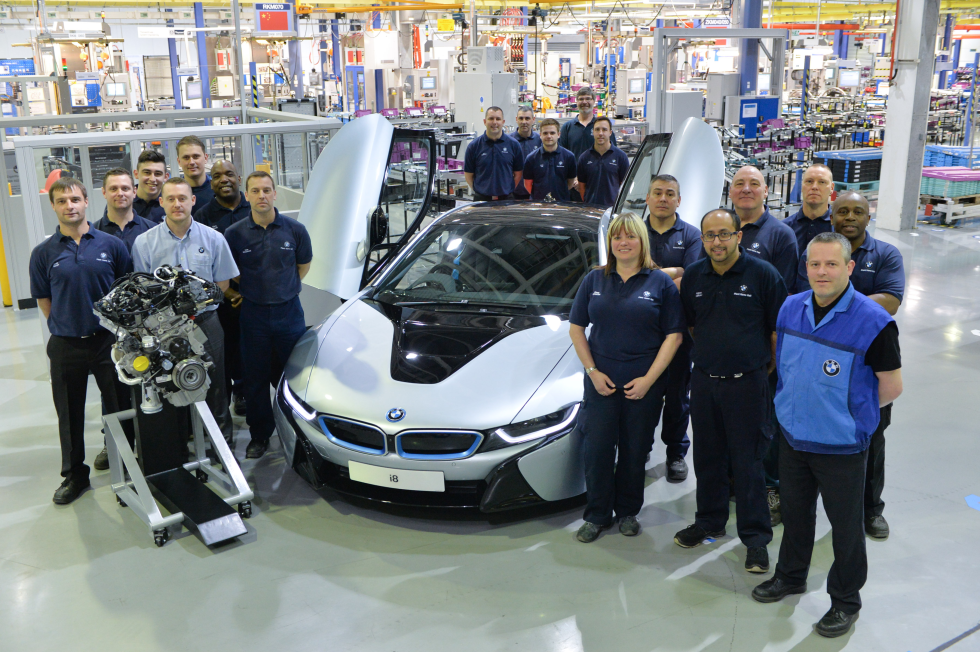Late last year, we reviewed BMW’s i3, a range-extended plug-in hybrid electric vehicle (PHEV) that impressed us despite its high price and limited range. That car is one half of BMW’s i Project, a sub-brand created to showcase the company’s vision of sustainable mobility. The i8 is the other half. It’s a plug-in hybrid sports car made from carbon fiber and aluminum. As such, it looks like very little else on the road.
But if this is what sports cars are going to be like in the future, we’re in for a real treat.
Design
Like its smaller city car sibling, the i8 combines a life module (the part you sit in) made out of carbon fiber joined to aluminum drive modules (the parts that make it go) clothed in thermoplastic body panels. Unlike the i3, it’s a low-slung machine. The drive modules are mated to the front and back of the life module, and the car’s 7.1kWh lithium-ion batteries run along the car’s centerline (between the seats). Large butterfly doors open up-and-out, imbuing the car with even more visual drama—something it wasn’t really lacking to begin with. This is a car that attracts attention. Introverts beware.
The i8 might look like a supercar, but pedants will point out that supercars should be capable of 200mph (321km/h) and have at least 500hp (373kW), neither of which descries this car. A 1.5L three-cylinder turbocharged internal combustion engine sits behind the rear seats sending 231hp (170kW) and 236ft-lbs (320Nm) to the rear axle through a six-speed Aisin automatic transmission. At the front, a BMW-designed and -built electric motor/generator sits between the front wheels. This uses a two-speed transmission to supply the front wheels with 131hp (96kW) and 184ft-lbs (250Nm). Working together, they give the i8 an award-winning 362hp (269kW) and 420ft-lbs (569Nm).
-
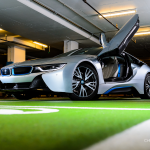
-
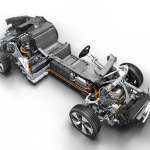
BMW
A cutaway of the i8’s chassis. The electric MGU is between the front wheels, the batteries live in-between the front seats, and the internal combustion engine is just ahead of the rear wheels.
-
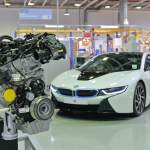
BMW
The i8’s internal combustion engine on display next to a car at BMW’s Hams Hall engine plant in the UK.
The British-built internal combustion engine—a detuned version of which sees action in the new Mini—features direct injection, variable valve timing , and the ability to rev freely to 6500rpm. It sounds good, too, if a little quiet. It pops and crackles on overrun, something that is fast becoming de rigueur among performance cars. It’s not just childishly amusing; continuing combustion for a moment in the exhaust actually helps burn off nitrogen pollutants (usually achieved by delaying the fuel injector cut-off and ignition spark). The i8 is one of an increasing number of cars that use their speakers to augment the engine’s soundtrack. This will be anathema to some, but let’s not pretend. Trick exhausts with valves that change the sound (or indeed any sports exhaust) are equally “contrived.”
What the MGU lacks aurally, it makes up for in grunt. All 184ft-lbs of torque are available at once, allowing the i8 to accelerate off the line more rapidly than its 3285lbs (1490kg) would suggest. The car can make short trips on electric power alone, with a range of up to 22 miles (35km) and a top speed of 75mph (120km/h). The i8 has three different modes: Eco Pro (for maximum efficiency), Comfort, and Sport. In the first two, the electric motor handles everything at low speed, shifting to the internal combustion engine kicking in once things get a little faster. In Sport, the engine is always running, and the i8’s electronic brains constantly decide how much power is appropriate for each axle.
How it’s built
When we call this a sports car with a social conscience, it’s because the i8’s commitment to sustainability goes beyond good gas mileage. The carbon fiber that makes up the life module begins life in Moses Lake, WA in a plant that’s a joint venture between BMW and SGL Group. The factory makes carbon fibers from polyacrylonitrile-based thermoplastic textile precursors, and it’s powered entirely by hydroelectric energy. Those carbon fibers are then sent to Wackendorf, Germany to be woven into laminates. Carbon fiber derives its strength from the alignment of the fiber strands. So the Wackendorf plant arranges stacks of laminates with each layer in the desired orientation and cuts them into the required shapes before sending them to the i8 assembly plant in Landshut, Germany.
At Landshut the carbon fiber laminates are arranged on molds before undergoing Resin Transfer Molding; a liquid resin is injected under high pressure, bonding to the fibers and hardening. This is now called carbon fiber-reinforced plastic, or CFRP. The process is substantially quicker than the more traditional method of carbon fiber production, which uses carbon fiber textiles pre-impregnated with resin (called pre-preg) that have to be cured in an autoclave for several hours. It’s still not as fast as stamping out steel panels, but the process is less energy intensive and the resulting panels are much lighter than a conventional panel of equivalent strength.
-

BMW
The i8’s engine is built at BMW’s Hams Hall factory in the UK.
-
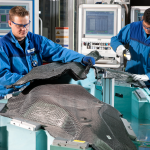
BMW
Workers at BMW’s plant in Landshut, Germany lay up sheets of carbon fiber on a mould.
-
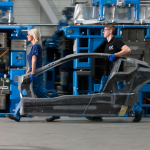
BMW
Carbon fiber panels are extremely light compared to steel or aluminium panels of an equivalent strength.
-
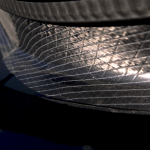
Jonathan M. Gitlin
The exposed carbon fiber sills of the safety cell.
Meanwhile, aluminum sheets and castings are combined to make the structure of the drive module at another BMW factory, this one in Dingolfing, Germany. Here, robots assemble lithium-ion cells into battery modules, which are connected in series and designed such that damaged or faulty ones can easily be removed and replaced if necessary.
Finally, a plant in Leipzig, Germany bonds together the CFRP panels to make the life module then add the interior. On a separate assembly line, the internal combustion engine (from Hams Hall, UK), electric motor (Landshut) gearboxes, and batteries (Dingolfing) are mated together. The two modules are ultimately bonded to each other before the body panels are attached. The assembly process takes 20 hours, a figure that BMW says is half that of a normal production process. Plus, since everything is bonded together, there’s no noisy welding. As one might expect after all these other choices in the name of efficiency, the Leipzig factory also uses entirely sustainable power (this time in the shape of wind turbines).
Listing image by Christopher Jason Studios


